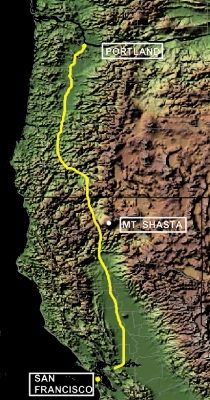Word of the Sutter’s Fort gold discovery reached Oregon in the summer of 1848. Oregon learned of the gold finds indirectly, not from travelers arriving straight from California.
Ships from California came to Oregon after stopping in Hawaii that summer. They brought the news about the gold. In July 1848, the brig Honolulu docked at Fort Vancouver in Oregon. The captain bought all the mining supplies he could find, intending to hurry to California and sell them at a huge profit. He claimed to want to supply coal miners, but word of the gold mines leaked out.

Oregonians then flocked to the gold fields. Men traveled from Oregon City and other points north down the Siskiyou Trail to California. (Interstate 5 follows the same approximate route from the Willamette Valley to California’s Central Valley.)
Their journey took several weeks. The Siskiyou Trail began as Native American footpaths along river valleys. It was so rugged that at first only mules and horses could make the way through the Siskiyou Mountains (in southern Oregon and northern California). A good day of travel meant covering fifteen to twenty miles of the 600 miles journey.
But soon wagon trains as long as those that had followed the Oregon Trail made the trip to Sutter’s Fort and the burgeoning town of Sacramento. Wagons took even longer to make the trip—a couple of months at best.
Despite the rigors of the trail, by the end of 1848, two-thirds of all adult males in Oregon had left for California to seek their fortunes. These men were adventurers by nature. Most of them had made the dangerous journey from the East to Oregon within the past five years. Still, desertion of their new home of this magnitude left Oregon bereft.

By September 7, 1848, The Oregon Spectator, the first newspaper published west of the Rockies, had to shut its operations for several weeks, just as the San Francisco papers had halted publication earlier in the spring.
Oregon farms could not harvest their crops. The families that remained in Oregon suffered from the loss of labor and a lack customers for their produce.
The Whitman Massacre was forgotten. The militia that had fought the Cayuse Indians was disbanded. It would take another two years before five Indians were hung for the crime.
All in the lust for gold.
When The Oregon Spectator resumed printing on October 12, 1848, the editors apologized:
The Spectator, after a temporary sickness, greets its patrons, and hopes to serve them faithfully, and as heretofore, regularly. That ‘gold fever’ which has swept about 3000 of her officers, lawyers, physicians, farmers, and mechanics of Oregon from the plains of Oregon into the mines of California, took away our printers.
The publishers went on to say:
Some of our fellow citizens express their fears that Oregon has been ruined, by the discovery of the late extensive gone mines of California. They ask—who will cultivate the ground when from $10 to $100 per day can be realized at the mines?
After waxing eloquent about the many advantages of Oregon, the editors said:
Oregon is temporarily injured by reason of so many of her citizens having left their farms, and shops, for the purpose of gold digging; but only temporarily.
The editors firmly believed in the bounty of Oregonian land, for not only the West, but for the nation as a whole. They argued that in the future Oregon would be seen for its great capacity to feed the nation.
[I]s such a country ruined, because gold mines are discovered in the neighborhood? Surely not; it should rather be regarded as a rich blessing, at the hands of the great, and wise Ruler of the Universe.
“All that Oregon has wanted, was a good market, the facilities for carrying her goods to market, and the protecting care of the home government; the home government, we trust, is about to extend her fostering care, the mines have already brought the desired market, the mines will bring facilities for carrying provisions to the mines; and the mines will materially contribute to make Oregon known, and develop her great resources.
Meanwhile, news of Californian gold reached back East. The St. Louis paper reported the gold find on August 8. The New York Herald reported the news on August 19. The Herald’s story was the first major East Coast mention of the gold discovery. However, its report was not confirmed, and did not immediately elicit any mass migration.
That would soon change.
Have you ever heard news that turned your life quickly from one path to another?




I love reading these excerpts from the newspaper, Theresa. I can only imagine what was going through these people’s minds.
A piece of news that stands out in my mind that changed my path was when the company I worked for announced we were being closed by corporate that day…my path quickly changed. Thankfully the path changed for the better.
Jill,
I’m glad the corporate move worked out for you. That is such a difficult time for people.
Theresa
So sad that this kind of thing, massacres, happened often in the pre-Gold Rush days. Greed is a dangerous emotion. I appreciate the research and the descriptions of how people handled this situation. Interesting post, Theresa!
Thanks for reading.
Actually, problems between whites and Native Americans didn’t happen often during the early years of the Oregon Trail. There weren’t enough whites to matter, and plenty of land. The Whitman Massacre in 1847 was an aberration. It wasn’t until the 1850s and later — after many people streamed into California for gold and land disputes became more common — that battles became more frequent.
Theresa